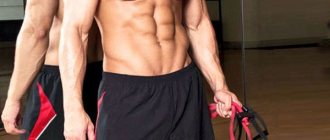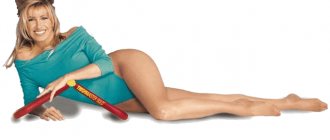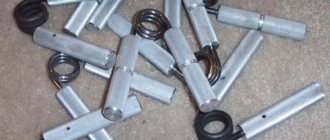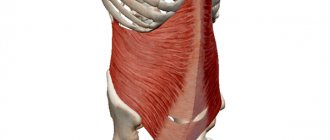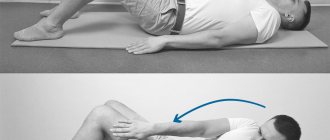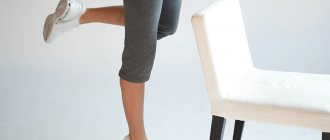What is a rubber band?
A rubber band is a universal tubular expander with handles that make it easier to hold the projectile. Thanks to this distinctive feature, a wide variety of exercises is available.
This apparatus is often used instead of the most common simulators. Throw the tourniquet over a stable object and perform various types of rows that will help strengthen your back muscles.
The expander is also ideal for developing the deltoid, biceps (biceps) and triceps (triceps) muscles of the arms. To do this, it is enough to secure the tourniquet under the foot and perform alternate lifting in front of you with each hand, abduction, flexion and extension at the elbow joints. You can find out more about the exercises below.
Why should you get a rubber band?
As mentioned above, a rubber expander can be both a replacement for the gym and an addition to it. When purchasing a projectile, decide for what purpose you are purchasing it.
If you want to tone your muscles, lose weight, and create beautiful body shapes, then a rubber expander is just the thing for this. In addition, a smooth tension of the tourniquet will allow you to safely conduct a workout, which is very important on the path of body development.
Rubber expanders, just like rubber loops, differ from each other in color. Each color indicates the corresponding degree of tension:
- Yellow – light load, suitable for beginners.
- Green – medium load, can be used confidently in most exercises. If this is easy for you, then move on to the next one.
- The red expander gives a large load and is suitable for trained men and women.
- Blue is the latest tourniquet in terms of tension; with its help, only advanced fitness enthusiasts will be able to perform exercises technically.
Some manufacturers produce black tourniquets for high-level athletes.
Exercises with a sports harness
The exercises are selected according to the “top to bottom” principle, that is, from the upper body to the lower. Choose those that will best suit your goals and needs.
- Tilts of the head (bending the neck) forward, backward and left and right - the tourniquet is on the corresponding parts of the body (if bending forward, the tourniquet is held on the forehead, backward - on the back of the head, and so on).
- Raising straight arms forward, to the sides, to the sides in an inclination - the legs stand in the middle of the tourniquet, both ends in the hands (deltoid muscles).
- Extension of the arms while standing or sitting is similar to the military press.
- Bent over arms extension from behind the head (triceps).
- Arm curls while standing or sitting (biceps).
- Straightening your arms while lying down is an analogue of the bench press (pectoral muscles).
- Raising your arms in front of your chest to the sides (stretching the pectoral muscles).
- Pullover with a tourniquet (pectoral and serratus muscles).
- The pull-down of the harness is analogous to the pull-down of the lower block (latissimus dorsi).
- One-arm bent-over harness row (lats).
- The bent over row of the harness is analogous to the bent over barbell row (latissimus, trapezius, shoulder blade muscles).
- Extensions with a tourniquet (back extensor muscles).
- Squats with a harness (hips, buttocks, lower back and lower abs).
- Deadlifts and deadlifts (hips, back).
- Flexion and extension of the legs with a tourniquet is an analogue of flexion and extension of the legs in a block exercise machine (hamstrings, buttocks and quadriceps).
- Taking the legs forward, to the side, back (quadriceps, hamstrings, inner thighs, buttocks).
- Standing calf raises with a tourniquet are analogous to calf raises in a machine.
Additionally, you can borrow special exercises from various sports. One of my friends is an arm wrestler, so he constantly ties a tourniquet to a battery and strengthens his hands, forearms and elbow joints through the usual flexion and extension of the corresponding joints.
Moreover, after time has passed, he constantly puts a load on himself - folds the tourniquet several times. You too can experiment and improvise with this flexible exercise machine.
So my article entitled “Rubber tourniquet for training” has come to an end. If you liked it, don't forget to subscribe to my blog updates or share it with your friends. Have you tried exercising with a sports harness? Leave your comment.
Precautionary measures
Before class, be sure to warm up your body with cardio exercises and warm up all your joints and muscles.
Training with a rubber band, as with any other equipment, must be accompanied by technically correct execution of the exercise. To do this, carefully study the movement technique, try to do several repetitions without weights. And only after that start a full workout.
Before performing the exercise, inspect the expander for tears or abrasions. If any defect is found, it is recommended to replace the harness. Otherwise, when performing the movement, the rubber expander may rupture and injure you.
Contraindications
Training with a rubber band, just like engaging in any other active activity, should improve health indicators and not harm the body. Therefore, you should familiarize yourself with a number of contraindications:
- deviations from the cardiovascular system;
- spinal instability;
- diseases of the respiratory system, kidneys in the acute stage;
- postoperative period;
- rheumatism, diseases of the digestive tract, gall bladder, liver;
- prolapse of internal organs, bending of the uterus, hernia of any location, malignant tumors of the pelvic organs;
- musculoskeletal injuries.
If in doubt, consult your doctor.
A set of exercises with an elastic band for the back
To avoid injury during training, you need to start with a warm-up. Before performing the main exercises, the muscles need to be warmed up (prepared) for the load.
At the end of the warm-up, you should do a little cardio training. Only after this can you proceed to performing basic exercises.
Standing stretches with elastic band
This exercise helps strengthen your back muscles. You can perform it with a fitness elastic band or a spring-type expander.
Stand straight with your feet shoulder-width apart. Holding the mini-trainer at chest level, spread your arms wide to the sides. Make sure that the tension is parallel to the floor surface, and do not lean forward or backward. The palms should be directed towards each other.
With a smooth movement, stretch the elastic band to its limit, opening the chest. Bringing your shoulder blades together, stay in this position for a few seconds. Now slowly return to the starting position.
Perform 3-4 sets of 10-12 reps.
Raising arms with a downward shift
Grab the edges of the rubber band with your palms and raise your arms straight above your head. Now slowly move one limb (right or left) behind your back, without bending, trying to lower it as low as possible. The central part of the elastic should be at the level of the back of the head.
Return to the starting position and perform the exercise with the other hand. Repeat the movements 10-12 times in 3-4 approaches.
Deadlift
From a standing position, step on the middle of the mini-simulator with both feet. Straighten your back and lean forward. Holding the edges of the elastic band with your palms, tighten your lower back muscles. Do not forget to look in front of you; you cannot lower your head while doing the exercise.
As you inhale, slowly straighten up, returning to a vertical position. Feel the muscles in your back and legs tighten. Repeat the inclines 8-12 times for 3-4 sets.
Squats with an expander band
You can use a long loop instead. When performing this exercise, the back, hips, and buttocks are involved.
Place your legs shoulder-width apart and place your feet in the middle of the band. Holding the edges of the machine with your hands, slowly squat while inhaling. As you exhale, return to the starting position. Repeat squats 10-12 times in 3 sets. During training, keep your back straight, avoid sudden jerks, and do not lean forward. This movement provides a moderate load on the lower back muscles and extensor muscles of the back.
Seated body bends
Another effective home exercise with a back band. In addition to the back muscles, when performing it, the abs, triceps and deltoids are involved.
Take a sitting position, straighten your legs and bring them together. Hold the ends of the mini-simulator in your palms, and place the central part behind your feet. Now exhale and gently lean back. When pulling the expander, you have to overcome the force, the muscles of the back, arms and buttocks become tense. When bending, pull your arms to the center of your body, bending them at the elbow joints. stay in this position for a while (2-3 seconds).
Lean forward as you inhale, straighten your body and sit up straight again. Repeat the movement 6-8 times for 2-3 sets.
Lying row
First of all, fix the machine on the wall. Lie on the floor with your head towards the fastening. Calculate the distance so that when your arms are pulled back (straightened), you feel the tension on the projectile.
Bend your legs at the knee joints, spread them slightly to the sides. Now forcefully pull the elastic band up and forward until your arms are in a vertical position. Don't bend your elbows or lift your lower back off the floor.
Try to hold this position for a few seconds, then return to the starting position. Repeat the movement 10-12 times in 3-4 approaches.
Standing row
Securely fasten the central part of the elastic band to the wall closer to the floor surface. Pressing the machine down with a weight is not an option. It may break due to the load, resulting in injury.
Hold the ends of the projectile with your hands, bend your legs slightly at the knees and lean forward. Bend elbow joints 90 degrees, torso 60 relative to the floor.
Looking ahead, move a few steps away from the place of fixation so that a strong tension is felt. As you inhale, slowly move back, overcoming resistance with the help of your back muscles. Rely on your spread legs to maintain your balance. Stay in this position for a few seconds, then return to the starting position. Take your time, perform the exercise 8-10 times in 3 approaches.
Remember, body rows should be mastered starting with a minimum load. Only when the action is given without much difficulty can you change the projectile to a new one with a higher level of rigidity.
Training with a back band is an ideal solution for beginner athletes and people with spinal problems. But if you periodically experience back pain, it is better to consult your doctor first. Exercises with such equipment help strengthen the back muscles and promote overall health. To achieve the desired result, it is not at all necessary to visit the gym. It is convenient to train with an expander at home.
You can read about how to create a training plan if you have back problems in this article.
Rubber band for learning pull-ups
Pull-ups are one of the basic exercises that have been taught since school. If you think that only men should be able to do pull-ups, you are deeply mistaken.
This gymnastic element determines the overall physical fitness of the body and is an alternative to many gym exercises. When performing it, the trapezius, latissimus, deltoid, biceps (biceps) and triceps (triceps) muscles develop.
The stabilizing muscle groups of the upper body, including the rectus abdominis, are also not ignored.
Do you want your arms to look beautiful and toned, and your posture to be impeccable? Then quickly buy a rubber expander and start training!
- Attach the handles of the expander to the edges of the crossbar.
- Stand on any hill. Take the horizontal bar with a normal grip, shoulder-width apart, and stand with your feet on the tourniquet so that it hangs underneath you.
- Bend your elbows, trying to touch your chest to the bar. And return back to the starting position.
- Perform 3 sets of 5-10 repetitions per workout. Try to add 1 pull-up every week. Once you can easily do 10 pull-ups with a rubber band, try doing pull-ups on your own.
Even if you are in good physical shape, training with a rubber expander will allow you to increase the number of pull-ups.
How to achieve this? It's simple: at the moment when you have completed the maximum number of repetitions using your own efforts, use a rubber band and pull yourself up a few more times.
The principle of training
As you may have guessed , rubber bands are sports devices that can give you the same load as when training with iron. The key point there is to increase working weights. And when training with an elastic band, you can measure progress with another indicator - the elasticity coefficient. The training principle is the same, only it takes much less time to train.
The training program should be built depending on your goal. If your goal is to practice gymnastics and maintain your body in normal physical shape, then one exercise for each muscle group will be enough for you. Choose a medium-hard band so you can do up to 30 reps per set.
If your goal is to acquire a sculpted body, or a slight increase in muscle mass, then you need to purchase several tourniquets with different stiffness coefficients. This is necessary in order to work all the muscles of your body as efficiently as possible. For example, your deltoids may be stronger than your biceps. Accordingly, they will need a stiffer elastic band
If you are a beginner athlete, then 2-3 workouts per week will be enough for you. Over time, you need to gradually increase the frequency of training to 5 times a week.
Training program (set of exercises)
Start working on yourself with three training sessions a week. Try to choose days so that the rest between them is approximately the same.
Perform each exercise in 3 approaches, rest between sets for 1-1.5 minutes. The number of repetitions is individual for each exercise and is indicated in parentheses.
A set of exercises for women
DAY 1
Perform each exercise in 2-3 approaches, rest between approaches for 1-1.5 minutes. The number of repetitions is individual for each exercise and is indicated in parentheses.
- Raising your arm in front of you using an expander (12 times)
- Abduction of the arm to the side using an expander (12 times)
- Pulling the leg back on all fours using an expander (20 times)
- “Swimmer” with an expander (25 times)
DAY 2
Perform each exercise in 2-3 approaches, rest between approaches for 1-1.5 minutes.
- Standing press using an expander (15 times)
- Bent-over abdominal row using an expander (15 times)
- Chest rows with expander (12 times)
- Squats with expander (25 times)
- Raising the torso on an inclined bench (Sitap) with an expander (15 times)
DAY 3
Perform each exercise in 2-3 approaches, rest between approaches for 1-1.5 minutes.
- External rotation of the shoulder using an expander (25 times)
- Horizontal row using an expander (15 times)
- Taking the leg back while standing using an expander (25 times)
- Squats with expander (20 times)
- “Swimmer” with an expander (20 times)
We recommend watching additional exercises for women in the following video.
A set of exercises for men
DAY 1
Perform 3-4 sets with 45-60 seconds rest in between.
- Standing press using an expander (15 times)
- Reduction of arms using an expander (15 times)
- Squats with expander (20 times)
- Raising the torso on an inclined bench (Sitap) with an expander (15 times)
DAY 2
Perform 3-4 sets with a rest of 45-60 seconds.
- Chest rows with expander (20 times)
- Bench press with expander (15 times)
- External rotation of the shoulder using an expander (20 times)
- Raising the torso on an inclined bench (Sitap) with an expander (15 times)
- “Swimmer” with an expander (25 times)
DAY 3
- Bent-over abdominal rows using an expander (20 times)
- Raising your arm in front of you using an expander (15 times)
- Abduction of the arm to the side using an expander (15 times)
- Reduction of arms using an expander (20 times)
- “Swimmer” with an expander (30 times)
We recommend watching additional exercises and complexes for men in the following videos.
Elements of training with a wrestling harness, which is largely similar in characteristics to a rubber expander (tourniquet), will help diversify your training.
And a specialized complex on hand.
Faster, tougher, stronger
A rubber expander allows you to develop all the qualities necessary for an athlete. The loops differ in thickness, which creates the desired resistance. Usually it is indicated on the tape and starts from 7-10 to 100 or more kilograms.
By stretching the rubber to the maximum, you can increase the strength and volume of muscles, increase the power and speed of blows, which is what complexes with a tourniquet for wrestlers are aimed at.
Exercises can be as follows:
- The development of punching power is used in boxing. The expander is fixed on the wall bars, the athlete stands at a distance of two meters with his back to the wall to keep the rubber taut. When performing a strike, additional force will be created, which will help develop both speed and strength;
- Developing throwing power is necessary for judokas. The tourniquet is also fixed on the wall, the wrestler faces it and takes the two ends in his hands. Making a body turn, he throws, pulling the rubber;
- Development of pushing force. The tourniquet is attached as in previous cases, the wrestler stands with his back to it, holding the ends in his hands. Performs a forward push, stretching the rubber as much as possible;
- A universal exercise for freestyle wrestling, judo and sambo. The wrestler stands facing the tourniquet fixed on the wall and holds both ends of it. The legs are shoulder-width apart, the body is inclined. With quick movements, move your hands behind one leg, while simultaneously taking a step to the side. Step back and place your hands behind your other leg.
